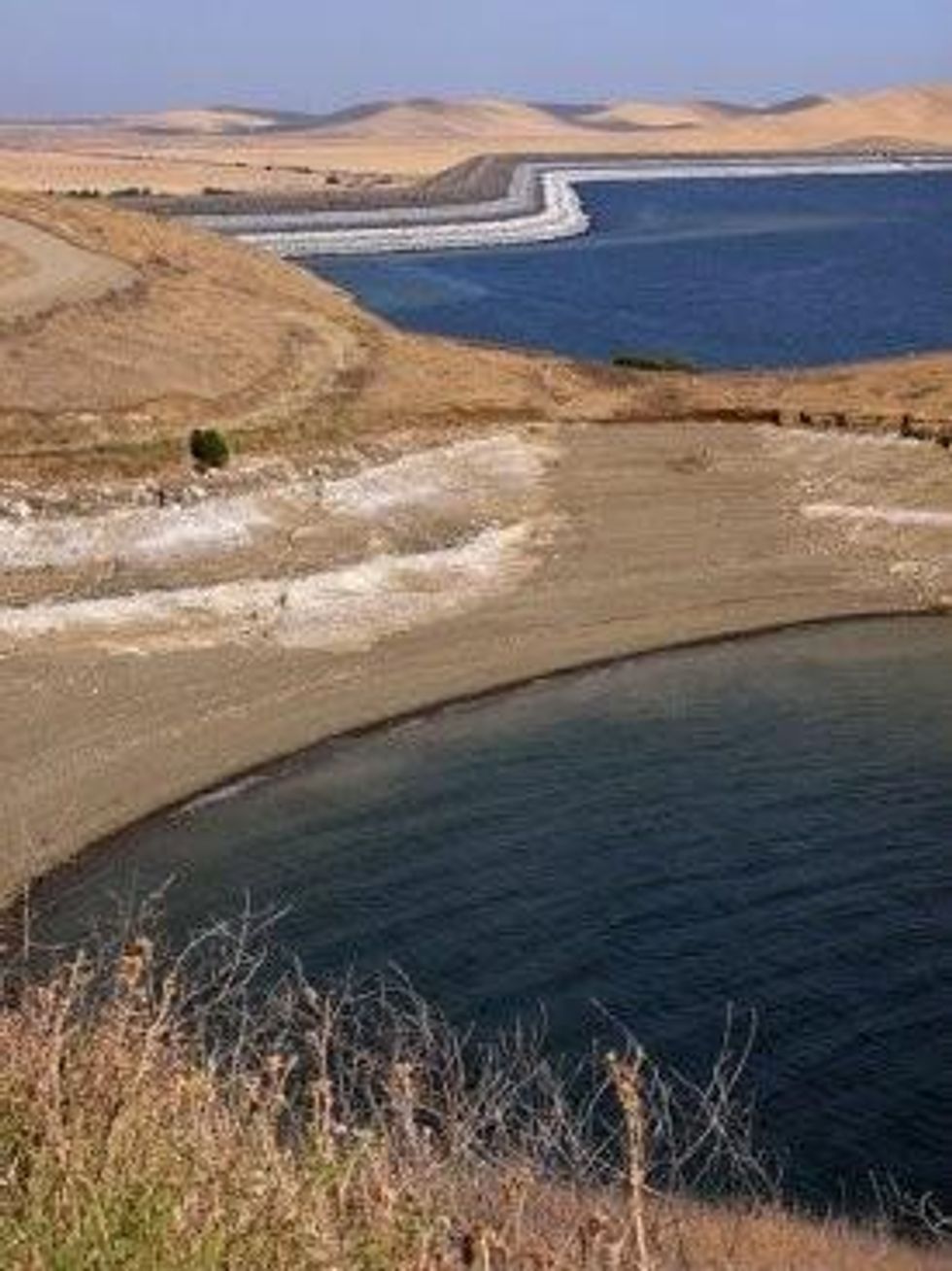Why California's Drought Affects Us All
With so much of the nation's food supply concentrated in the "Shake and Bake" state, its good weather is bad news for us all.
As a Californian, I have not gotten too much sympathy from friends and family about our rotten weather this winter. Yes, I said rotten weather. It's been incredibly pleasant-- except for a few times when the temperature crept up to 90 -- but we've hardly had any rain.

California's climate problems have nothing to do with human comfort -- but they have everything to do with human food. And not just for California.
Unfortunately for the rest of the country, Californians provide a huge share of the nation's fruits and vegetables. If we can't grow crops because we have no water, everybody misses out.
A recent Mother Jones article points out that nearly all of America's almonds, walnuts, strawberries, broccoli, grapes, and more come from the Golden State. And just one walnut requires a whopping 4.9 gallons of water. That's not 4.9 gallons for a pound of walnuts. That's for just one nut. A stick of butter? That takes 109 gallons of water to produce.
It's more than a little crazy that a state without much water provides the nation with nearly half of its fruit, nuts, and vegetables. And yeah, you can't judge California's water supplies based on this year alone since it's one of the driest years on record. But whether the current drought continues (as some experts predict) or the recent downpours herald a break in this dry spell, we are foolish to put all of our agricultural eggs in one geographic basket.
The prominent food writer Michael Pollan once made the point that efficiency in agriculture comes at the expense of resilience, and vice versa. To date, it's been efficient to produce 95 percent of America's broccoli in just a few California counties. But that also means that one natural disaster could take out the majority of our broccoli supply in a given year.
California is blessed with a mild Mediterranean climate and seemingly unlimited sunshine, but it's not for nothing that we call ourselves the "Shake 'n Bake" state. Earthquakes and wildfires are only two of our specialties -- we've also got mudslides, flash floods, and now this terrible drought.
Even in wet years, it doesn't rain much.
When farmers concentrate the growth of a single crop in one area, we risk losing that crop to an outbreak of pests or disease. That is even truer when farmers grow the same variety of the same crop. Think grove after grove of Valencia oranges, without any Navels in sight.
Our current farming system arose out of a drive for efficiency. If we grow all of the tomatoes (or lettuce or broccoli) in one spot, then the farmers benefit from an entire distribution and processing system centralized in their area. Perhaps there's a tomato canning plant or a ketchup factory nearby.
This system currently gives us the cheapest food in the world. Americans spend less than 10 percent of our disposable income on food, less than any other nation.
Yet our cheap food system is inherently risky. A few years ago, a drought across most of the country radically reduced our corn production. California's ongoing drought will reduce the supply of many fruits, nuts, and vegetables.
With the changing climate, we can expect more weather extremes and the crop failures they sow. Let's build resiliency into our food system by growing fruits, nuts, and vegetables across the country instead of concentrating way too much of our food in one drought-prone state.
An Urgent Message From Our Co-Founder
Dear Common Dreams reader, The U.S. is on a fast track to authoritarianism like nothing I've ever seen. Meanwhile, corporate news outlets are utterly capitulating to Trump, twisting their coverage to avoid drawing his ire while lining up to stuff cash in his pockets. That's why I believe that Common Dreams is doing the best and most consequential reporting that we've ever done. Our small but mighty team is a progressive reporting powerhouse, covering the news every day that the corporate media never will. Our mission has always been simple: To inform. To inspire. And to ignite change for the common good. Now here's the key piece that I want all our readers to understand: None of this would be possible without your financial support. That's not just some fundraising cliche. It's the absolute and literal truth. We don't accept corporate advertising and never will. We don't have a paywall because we don't think people should be blocked from critical news based on their ability to pay. Everything we do is funded by the donations of readers like you. Will you donate now to help power the nonprofit, independent reporting of Common Dreams? Thank you for being a vital member of our community. Together, we can keep independent journalism alive when it’s needed most. - Craig Brown, Co-founder |
As a Californian, I have not gotten too much sympathy from friends and family about our rotten weather this winter. Yes, I said rotten weather. It's been incredibly pleasant-- except for a few times when the temperature crept up to 90 -- but we've hardly had any rain.

California's climate problems have nothing to do with human comfort -- but they have everything to do with human food. And not just for California.
Unfortunately for the rest of the country, Californians provide a huge share of the nation's fruits and vegetables. If we can't grow crops because we have no water, everybody misses out.
A recent Mother Jones article points out that nearly all of America's almonds, walnuts, strawberries, broccoli, grapes, and more come from the Golden State. And just one walnut requires a whopping 4.9 gallons of water. That's not 4.9 gallons for a pound of walnuts. That's for just one nut. A stick of butter? That takes 109 gallons of water to produce.
It's more than a little crazy that a state without much water provides the nation with nearly half of its fruit, nuts, and vegetables. And yeah, you can't judge California's water supplies based on this year alone since it's one of the driest years on record. But whether the current drought continues (as some experts predict) or the recent downpours herald a break in this dry spell, we are foolish to put all of our agricultural eggs in one geographic basket.
The prominent food writer Michael Pollan once made the point that efficiency in agriculture comes at the expense of resilience, and vice versa. To date, it's been efficient to produce 95 percent of America's broccoli in just a few California counties. But that also means that one natural disaster could take out the majority of our broccoli supply in a given year.
California is blessed with a mild Mediterranean climate and seemingly unlimited sunshine, but it's not for nothing that we call ourselves the "Shake 'n Bake" state. Earthquakes and wildfires are only two of our specialties -- we've also got mudslides, flash floods, and now this terrible drought.
Even in wet years, it doesn't rain much.
When farmers concentrate the growth of a single crop in one area, we risk losing that crop to an outbreak of pests or disease. That is even truer when farmers grow the same variety of the same crop. Think grove after grove of Valencia oranges, without any Navels in sight.
Our current farming system arose out of a drive for efficiency. If we grow all of the tomatoes (or lettuce or broccoli) in one spot, then the farmers benefit from an entire distribution and processing system centralized in their area. Perhaps there's a tomato canning plant or a ketchup factory nearby.
This system currently gives us the cheapest food in the world. Americans spend less than 10 percent of our disposable income on food, less than any other nation.
Yet our cheap food system is inherently risky. A few years ago, a drought across most of the country radically reduced our corn production. California's ongoing drought will reduce the supply of many fruits, nuts, and vegetables.
With the changing climate, we can expect more weather extremes and the crop failures they sow. Let's build resiliency into our food system by growing fruits, nuts, and vegetables across the country instead of concentrating way too much of our food in one drought-prone state.
As a Californian, I have not gotten too much sympathy from friends and family about our rotten weather this winter. Yes, I said rotten weather. It's been incredibly pleasant-- except for a few times when the temperature crept up to 90 -- but we've hardly had any rain.

California's climate problems have nothing to do with human comfort -- but they have everything to do with human food. And not just for California.
Unfortunately for the rest of the country, Californians provide a huge share of the nation's fruits and vegetables. If we can't grow crops because we have no water, everybody misses out.
A recent Mother Jones article points out that nearly all of America's almonds, walnuts, strawberries, broccoli, grapes, and more come from the Golden State. And just one walnut requires a whopping 4.9 gallons of water. That's not 4.9 gallons for a pound of walnuts. That's for just one nut. A stick of butter? That takes 109 gallons of water to produce.
It's more than a little crazy that a state without much water provides the nation with nearly half of its fruit, nuts, and vegetables. And yeah, you can't judge California's water supplies based on this year alone since it's one of the driest years on record. But whether the current drought continues (as some experts predict) or the recent downpours herald a break in this dry spell, we are foolish to put all of our agricultural eggs in one geographic basket.
The prominent food writer Michael Pollan once made the point that efficiency in agriculture comes at the expense of resilience, and vice versa. To date, it's been efficient to produce 95 percent of America's broccoli in just a few California counties. But that also means that one natural disaster could take out the majority of our broccoli supply in a given year.
California is blessed with a mild Mediterranean climate and seemingly unlimited sunshine, but it's not for nothing that we call ourselves the "Shake 'n Bake" state. Earthquakes and wildfires are only two of our specialties -- we've also got mudslides, flash floods, and now this terrible drought.
Even in wet years, it doesn't rain much.
When farmers concentrate the growth of a single crop in one area, we risk losing that crop to an outbreak of pests or disease. That is even truer when farmers grow the same variety of the same crop. Think grove after grove of Valencia oranges, without any Navels in sight.
Our current farming system arose out of a drive for efficiency. If we grow all of the tomatoes (or lettuce or broccoli) in one spot, then the farmers benefit from an entire distribution and processing system centralized in their area. Perhaps there's a tomato canning plant or a ketchup factory nearby.
This system currently gives us the cheapest food in the world. Americans spend less than 10 percent of our disposable income on food, less than any other nation.
Yet our cheap food system is inherently risky. A few years ago, a drought across most of the country radically reduced our corn production. California's ongoing drought will reduce the supply of many fruits, nuts, and vegetables.
With the changing climate, we can expect more weather extremes and the crop failures they sow. Let's build resiliency into our food system by growing fruits, nuts, and vegetables across the country instead of concentrating way too much of our food in one drought-prone state.

